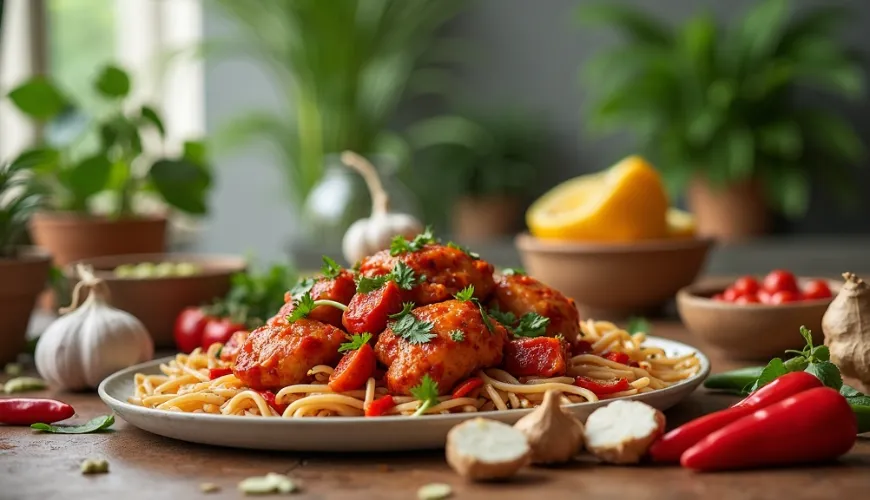
Spicy Szechuan Chicken is an ideal recipe for a weekend lunch

Exotic on the Plate - Szechuan Chicken Will Teach You to Love Spicy Food
When you think of Chinese cuisine, most of us imagine sweet and sour sauces, fried noodles, or crispy spring rolls. However, China is not just one universal gastronomic direction. It is a country with diverse culinary traditions, and the province of Sichuan (S'-chuan) is among the most distinctive regions with its own flavor, which is unmistakably spicy, aromatic, and incredibly addictive. This is where Szechuan chicken comes from, which has become popular here too—not only in restaurants but also in home kitchens.
What Does Sichuan Taste Like?
Sichuan cuisine is known for its ability to combine spicy, sour, sweet, and salty flavors into one harmonious whole. A characteristic feature is the use of Szechuan pepper, which has a slightly lemony flavor and a specific numbing effect—a gentle tingling on the tongue. This pepper, combined with chili peppers, creates a flavor profile that the Chinese call "ma la," meaning spicy and numbing. When you add tender chicken meat, crispy vegetables, and a sticky sauce, it creates a dish that surprises even experienced gourmets.
In the Czech environment, Szechuan chicken has been appearing for several years. Some encountered it in a good Asian restaurant, others might have seen it in the TV kitchen of the famous chef Zdeněk Pohlreich. Pohlreich's version of the Szechuan chicken recipe has inspired many home cooks who like to try something spicier than classic Czech schnitzels or svíčková.
What Makes the Flavor of Szechuan Chicken?
The recipe for Szechuan chicken can vary depending on the specific source, but the basic ingredients are usually similar. A key role is played by quality chicken meat—ideally breasts or boneless thigh fillets, as they remain juicier. Garlic, ginger, spring onions, and of course the sauce, which forms the heart of the whole dish, are added. This usually includes soy sauce, rice vinegar, sugar, and chili paste or fresh chili peppers. Szechuan pepper, if you can get it, elevates the dish to a higher level.
The dish is traditionally served with boiled jasmine rice, which gently reduces the spiciness and acts as the perfect complement to the bold sauce. Szechuan chicken with rice is thus a complete plate full of flavors and aromas that satiates and delights.
Sichuan Cuisine at Home? No Problem
You might think that such an exotic dish must be difficult to prepare and require unusual ingredients. The opposite is true. Most ingredients can easily be found today in larger supermarkets or in health food stores and Asian grocery stores. If you are mindful of the origin of your food and prefer more sustainable options, it pays to opt for organic chicken meat from ecological farms. Choose sauces and spices in their purest form without glutamates and artificial preservatives.
An interesting trend is adapting original recipes to modern dietary trends. There are, for example, vegetarian versions of Szechuan chicken, where chicken meat is replaced with tofu or tempeh. The result? Just as tasty, but a bit lighter and ideal for those avoiding animal products.
Recipe - Szechuan Chicken Step by Step
To give an idea of how such a dish is made, here's a simple home recipe for Szechuan chicken, inspired by classic versions and adapted for common Czech kitchens. Ideally, if you have a wok, but a deeper pan will suffice.
You will need:
- 500 g of chicken breasts or boneless thigh fillets
- 2 tablespoons of tamari or soy sauce
- 1 teaspoon of corn starch
- 2 cloves of garlic (chopped)
- 1 tablespoon of fresh ginger (grated)
- 1 small red chili pepper (chopped, optional)
- 1 teaspoon of Szechuan pepper (optional but recommended)
- 1 tablespoon of rice vinegar
- 1 tablespoon of cane sugar
- 1 teaspoon of sesame oil
- 1 spring onion (chopped)
- vegetable oil for frying
- cooked jasmine or basmati rice for serving
Procedure:
- Slice the chicken meat into thin slices and mix with starch and a tablespoon of soy sauce. Let it marinate for at least 15 minutes.
- Heat oil in a frying pan or wok and quickly fry the meat until golden. Remove and set aside.
- In the same pan, sauté garlic, ginger, and chili. Add Szechuan pepper and briefly heat.
- Return the meat to the pan, add the remaining soy sauce, sugar, vinegar, and sesame oil. Mix well and heat for a few minutes to blend the flavors.
- Finally, add the spring onion and serve immediately with freshly cooked rice.
The result is juicy and spicy chicken meat in an aromatic sauce that transports you to the alleys of Chengdu or Chongqing, where the scent of spices mixes with street noise and steam from bamboo steamers.
Culture That Creates an Experience
Sichuan cuisine is not just about food. It's also a way to enjoy life. In China, people sit at the table for a long time, eat slowly, and share taste and company. Perhaps that's why such dishes are ideal for a weekend lunch with friends or family. Preparing Szechuan chicken at home is not just about cooking—it's a small travel experience without having to pack your bags.
Interestingly, Zdeněk Pohlreich, in his version of the recipe, opted for a simpler and less spicy variant, which is ideal for those just starting with spicy foods. His Szechuan chicken according to Pohlreich is inspired by traditional cuisine but adapted for European tastes. The result is balanced and perfectly suited for more festive occasions.
As the famous American writer and gourmet Anthony Bourdain rightly noted: "Food is about where you have been, what you have experienced, and with whom you shared it." Perhaps thanks to recipes like Szechuan chicken, we have the opportunity to taste the world without leaving our own kitchen.
Whether you opt for the original version with authentic ingredients or go your own way and adjust the recipe to your possibilities, one thing is certain—Szechuan chicken has rightfully become one of the most popular Asian dishes in Czech households. Thanks to its distinctive taste, easy preparation, and versatility, it has become a new staple not only among spicy food lovers.
So what do you say, will you try swapping the classic svíčková for a taste of the Orient tonight?

